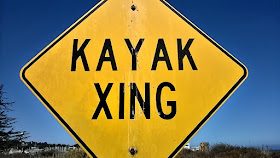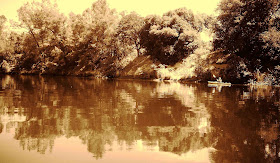He said I wanna see you again. But I'm stuck in colder weather. Maybe tomorrow will be better --The Zac Brown Band
I was hoping to get one more day in. Just one more day on the water. The early winter weather had been typical and Fargo-like. The first snow had come early October, followed by another a week later.
My days of paddling were quickly running out. My kayak world looked like a shaken snow globe. The dark waters of the Red River flowed past the banks of white snow in a dream-like setting. Along the shore, a thin layer of ice formed over the water. I can still recall the sound of my kayak's bow breaking through the ice. A reverberation of radio static and breaking glass echoed over the peaceful river. The Red was not a far cry from the Arctic.
"We hit a point where the ocean was all these pieces of broken ice," explorer
Erik Boomer, told
Canoe and Kayak Magazine, "It was just huge cliffs and bad ice, and the ice was traveling four or five miles a day, so a lot of movement. One idea we had was to jump out on a large piece of ice and sail it through a strait. So we hopped on some ice, set up camp, and joked about being on a big icebreaker ship."
He was recalling his epic trip with Jon Turk as they became the first paddlers to circumnavigate the 1,485-mile around Ellesmere Island, in the high Canadian Arctic in 2011. They skied and walked, towing their boats, about 850 miles, and paddled the remaining 600. "We both slipped in once—into the freezing cold Arctic Ocean. We made sure we always traveled real tight together and helped each other when we were seal launching off of a piece of ice, or climbing a piece of ice because there was always danger. And there was also danger of being squashed by the ice."
Ice would all too soon squash my plans. Thanksgiving weekend was mild and pleasant, with a little luck I thought, the weather would hold and I could paddle into December. But, a cold front rolled in freezing everything it touched. The river and lakes were entrenched with ice and snow, leaving the only memories, ghosts of days of the past season. Scottish poet Walter Scott had it right when he penned, "
When dark December gloom's the day, And takes our autumn joys away; When short and scant the sunbeam throws, Upon the weary waste of snows." My snow-covered kayak still loaded on the top of the van, was about to make its last and shortest voyage of the year... into the garage.
"One thing that we observed and talked about is how we were watching the ice change and the seasons literally go through these transitions," said Boomer, looking back on his experience in the Arctic, "It gave me a different perspective on changes and transitions. Changes and transitions are always difficult, you have to literally change your method working through it, but they’re bound to happen."
Now my boats have been loaded and unloaded off and on, and into the garage since last spring, but for me, there is something final about the last portage of the year. Lowering the kayak off the van's roof and onto the rack inside my single stall garage, I sandwiched it between two other boats along the wall. The van, only used for kayaking was then slowly backed into place in the garage as well, locked away for the winter. When the garage door shut, my kayaking was over until next spring.
"I actually don't even see my kayak when it's in storage. Your message prompted me to go out and confirm it's still where I left it!" said Heather Schmidt, who split her time between Fargo and Duluth, Minn, "What's painful for me, is seeing the water on the big lake so calm and seemingly inviting during the colder days. I don't have a wet-suit, so most of the year, paddling is out-of-bounds for me, but I still drive by the calm, beautiful water that is calling for a kayak to cut through its waters."
Withdrawal would soon occur.
Psychiatrist William Glasser said, "We are driven by five genetic needs: survival, love and belonging, power, freedom, and fun." Glasser claims that positive addictions “strengthen us and make our lives more satisfying.” Positive addictions, like kayaking, enhance life. They also help us to “live with more confidence, more creativity, and more happiness, and usually in much better health."
When I stopped paddling for the season, symptoms of kayak withdrawal seem to emerge, and from what I was told there was no cure.
"There is one thing I should warn you about before you decide to get serious about canoeing." warned paddling guru
Bill Mason, "You must consider the possibility of becoming totally and incurably hooked on it. You must also face the fact that every fall about freeze-up time you go through a withdrawal period as you watch the lakes and rivers icing over one by one. Cross-country skiing and snowshoeing can help a little to ease the pain, but they won’t guarantee a complete cure."
It was an unusually long winter that year in Fargo-Moorhead. Not that that wasn't out of the ordinary. I had been there for nearly 30 years and only recall a few mild ones. At -13 below it hard to find anything but frozen water anywhere. The Red River had the look of a ribbon-thin glacier splitting the two cites in half. Historians say, they use to set up bleachers on the ice and have horse-drawn sleigh races along a section of the river. Only water trickles over the rocks of the Midtown dam producing a billowing layer of ice fog gaping between the two ice masses. On cross-country ski outings along the river, I would often ponder those paddling days.
"Winter is a time of promise because there is so little to do," said writer Stanley Crawford, "Or because you can now and then permit yourself the luxury of thinking so."
Canadian sea kayaker
Harvey Chris Wittenberg, put this way, "Every year lands up being a little unique with different memories," he wrote in an email, "In Canada where six months a year we are locked in with ice. Well, it makes you appreciate the kayaking a little more. It lands up being a time to reflect. Dream up bucket-list plans for next season as well as think about new equipment and setting goals for the upcoming season."
I'm a Californian now. I can paddle every day all year-long which I still find remarkable and almost unexpected. There is no ice or snow unless I want to take my kayak up into the Sierra-Nevada Mountains for winter paddle. The thought that had crossed my mind.
During my last winter in Fargo while in a long-distance courtship with my soon to be wife, I remember how she would send me shots along the
American River, coaxing me to come to California. Folks paddling along on a sunny day, while I looked out my window saw the bleakness of winter. It was like looking at a menu and not being able to order anything but frozen fish sticks while counting the days down to spring.
"So it just sorta became normal life." said Boomer, summing up his 104 days in the Arctic with Turk, "There wasn’t anything else, and that’s really what life is. You’re there. And I think in working through those challenges, I’m hoping to bring that into my everyday life—the adventure, the excitement, the specialness of every single day, and continually taking on challenges and having fun with them.”





















































